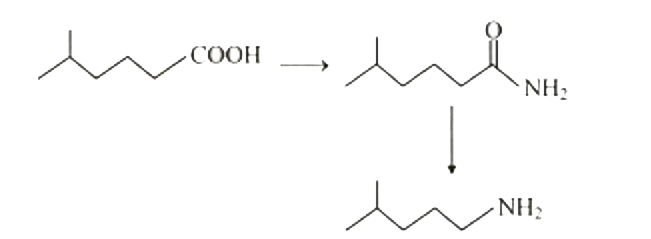Complete Solutions to CHEMISTRY of chapter NTA JEE MOCK TEST 90 of Class 12 book with complete answers and questions
| Class 12 | CHEMISTRY |
| Chapter | NTA JEE MOCK TEST 90 |
| NTA MOCK TEST | CHEMISTRY |
| Number Of Questions | 25 |
| Academic Year | 2023-24 |
Which of the following complex ions is expected to absorb visible light?
View SolutionPredict the percentage of isomers formed during monobromination of 2,3-dimethyl butane at room temperature. Relative reactivity of `1^(@)` , `2^(@)` , `3^(@)` H atoms to chlorination is `(1.0 : 3.8 : 5.0)` .
View SolutionThe IUPAC name of the given structure `CH_(3)-overset(O)overset(||)C-overset(Br)overset(|)CH-underset(I)underset(|)CH-COOH` is-
View SolutionWhich of the following statements is (are) incorrect?
(i) Percentage ionic character in `CsCl` bond is `~55%`. (Electronegativity values of Cs and Cl are 0.7 and 3.0 respectively)
(ii) From `H_(2)O` to `H_(3)O^(+)`, the geometry around O atom changes drastically .
(iii) The most stable oxidation state for element with atomic number 113 is expected to be `+2`.
(iv) The `2^("nd")` ionization energy of Ca is greater than `1^("st")` ionization energy of it but lower then `2^("nd")` ionization energyof K.
View SolutionOut of the following ions `Ti^(3+), V^(3+), Cu^(+), Sc^(3+), Mn^(3+) and Co^(2+)` the colourless ions will be
View SolutionThe product (A) of the following reaction

View SolutionConsider the following carbanions :

Correct decreasing order of stability is -
View Solution`Ag_(2)S +NaCN rarr (a)`
(a) `+Zn rarr (d)`
(b) is a metal. Hence `(a)` and `(b)` are
View SolutionWhich of the following option is correct for given curve?

View SolutionAcetone on addition to methyl magnesium bromide forms a complex, which on decomposition with acid gives X and `Mg(OH)Br.` Which one of the following is X?
View Solution`A+H_(2)O to B+HCl`
`B+H_(2)O to C+HCl`
Compound (A), (B) and (C) will be respectively:
View SolutionWhich of two water sample A & B with BOD of 10ppm and 20 ppm respectively, then mark correct option
View SolutionA compound A dissociate by two parallel first order paths at certain temperature
`A(g)overset(k_(1)("min"^(-1))rarr 2B(g)k_(1)=6.93xx10^(-3)"min"^(-1)`
`A(g)overset(k_(2)("min"^(-1))rarrC(g) k_(2)=6.93xx10^(-3)"min"^(-1)`
If reaction started with pure 'A' with 1 mole of A in 1 litre closed container with initial pressure (in atm) developed in container after 50 minutes from start of experiment?
View SolutionOn subjecting 10ml mixture of `N_(2)` and CO to repeated electric spark to form `CO_(2)` and NO, 7 ml of `O_(2)` was required for combustion. What was the mole precent of CO in the mixture ? (All volumes were measured under identical conditions)
View SolutionThe increasing order of `Ag^(+)` ion concentration in
I. Saturated solution of `AgCl`
II. Saturated solution of `Agl`
III. `1MAg(NH_(3))_(2)^(+)" in "0.1 M NH_(3)`
IV. `1MAg(CN)_(2)^(-)" in "0.1 M KCN`
Given :
`K_(sp)" of "AgCl=1.0xx10^(-10)`
`K_(sp)" of "Agl=1.0xx10^(-16)`
`K_(d)" of "Ag(NH_(3))_(2)^(+)=1.0xx10^(-8)`
`K_(d)" of "Ag(CN)_(2)^(-)=1.0xx10^(-21)`
View SolutionA `100 ml` solution of `0.1 N HCl` was titrated with `0.2`? `N NaOH` solution. The titration. The remaining titration war completed by adding `0.25 N KOH` solution. The volume of `KOH` required for completing the titration is
View SolutionHydrocarbon`(A)` reacts with bromine by substitution to form an alkyl bromide which by Wurtz reaction is converted to gaseous hydrocarbon containing less than four carbon atoms `(A)` is
View SolutionMole fraction of the toluene in the vapour phase which is in equilibrium with a solution of benzene (`p^(@) = 120` torr ) and toluene (`p^(@)`=80 torr) having 2.0 mol of each is :
View SolutionWhen two compounds `Acl_(3) and DCl_(3)` of two elements A and D are mixed together a compound `ADCl_(6)` is formed. Structural analysis showed that `AdCl_(6)` is an ionic compound. Given that `DCl_(3)` is trigonal planar and `Acl_(3)` is trigonal pyramidal, predict the shape of the anion `DCl_(4)^(-)`.
View SolutionPegarding the structure of `SO_(2) and SeO_(2)` which of the following is true-
View SolutionCalculate the equilibrium constant for the reaction : `Fe^(2+)+Ce^(4+)hArr Fe^(3+)+Ce^(3+)` Given, `E_(Ca^(4+)//Ce^(3+))^(@)=1.44V` and `E_(Fe^(3+)//Fe^(2+))^(@)=0.68V`
View SolutionConsider the following conversion :

Amongst the following, how many methods can be used in any one of steps involved in the mentioned conversion?
i. Hoffmann bromamide degradation
ii. Gabriel phthalimide synthesis
iii. Sandmeyer reaction
iv. Clemmensen reduction
v. Mendius reduction
View SolutionThe surface of copper gets tarnished by the formation of copper oxide. `N_(2)` gas was passed to prevent the oxide formation during heating of copper at 1250 K. However, the `N_(2)` gas contains 1 mole % of water vapour as impurity. The water vapour oxidises copper as per the reaction given below: `2Cu(s) + H_(2)O(g) rarr Cu_(2)O(s) + H_(2)(g)` is the minimum partial pressure of H2 (in bar) needed to prevent the oxidation at 1250 K. The value of ln is ____. (Given: total pressure = 1 bar, R (universal gas constant) = `8 J K−1 mol^(−1), ln(10) = 2.3. Cu(s) and Cu_(2)O(s)` are mutually immiscible. At 1250 `K: 2Cu(s) + 1//2 O_(2)(g) rarr Cu_(2)O(s)`
`triangle H^(theta) = − 78,000 J mol^(−1)`
`H_(2)(g) + 1//2 O_(2)(g) rarr H_(2)O(g), triangle G^(theta) = − 1,78,000 J mol^(−1)`, G is the Gibbs energy
View Solution`3 -" Methylbutane" - 2 - ol +Hl overset(Delta)rarrX` Idenfity the position of carbon in the main chain to which nucleophile is added in the product 'X'?
View SolutionCalculate the osmotic pressure in pascals exerted by a solution prepared by dissolving `1.0g` of polymer of molar mass `185,000` in `450mL` of water at `37^(@)C`.
View Solution
CHEMISTRY questions and complete solutions for chapter NTA JEE MOCK TEST 90 of NTA MOCK TESTS of Class 12